MPPT of Permanent Magnet Synchronous Generator in Tidal Energy Systems Using Support Vector Regression
Abstract
1. Introduction
- It is a predictable resource as it depends on the tides.
- It has a slight environmental impact, but much less than other electricity generation systems, both renewable and conventional.
- A tidal turbine with a current speed of between 2 and 3 m/s can obtain about four times more annual power than an equivalent wind turbine. So the increase in cost of both installation and maintenance of the tidal power system is more than offset by the increase in production.
2. Mathematical Model of Tidal Energy System
2.1. The Mathematical Model of Tidal Turbine
2.2. PMSG Modeling
2.3. Grid-Side Control
3. Support Vector Regression (SVR)
3.1. SVR Algorithm
3.2. MPPT Using SVR
- By collecting a sufficient number of testing or training samples of pre-specified turbine power, rotor rotational speed and the tidal current speed, the preparation step is achieved.
- The training samples are then used in an offline step that is called training process for SVR to assess each particle fitness value in the regression.
- The on-line estimation model is then obtained by retrain the SVR optimal parameters.
4. Experimental Results
5. Conclusions
Author Contributions
Funding
Institutional Review Board Statement
Informed Consent Statement
Data Availability Statement
Acknowledgments
Conflicts of Interest
References
- Sabzehgar, R. A Review of Ocean Wave Energy Conversion Systems. In Proceedings of the IEEE Electrical Power & Energy Conference, Montreal, QC, Canada, 22–23 October 2009. [Google Scholar]
- Segura, E.; Morales, R.; Somolinos, J.A.; Lopez, A.A. Techno-economic challenges of tidal energy conversion systems: Current status and trends. Renew. Sustain. Energy Rev. 2017, 77, 536–550. [Google Scholar] [CrossRef]
- Uihlein, A.; Magagna, D. Wave and tidal current energy—A review of the current state of research beyond technology. Renew. Sustain. Energy Rev. 2016, 58, 1070–1081. [Google Scholar] [CrossRef]
- El Tawil, T.; Charpentier, J.F.; Benbouzid, M. Tidal energy site characterization for marine turbine optimal installation: Case of the Ouessant Island in France. Int. J. Mar. Energy 2017, 18, 57–64. [Google Scholar] [CrossRef]
- Winter, A.I. Differences in fundamental design drivers for wind and tidal turbines. In Proceedings of the 2011 IEEE-Spain OCEANS, Santander, Spain, 6–9 June 2011; pp. 1–10. [Google Scholar]
- Sousounis, M.C.; Shek, J.K.H.; Mueller, M.A. Modelling and control of tidal energy conversion systems with long distance converters. In Proceedings of the 7th IET International Conference on Power Electronics, Machines and Drives (PEMD 2014), Manchester, UK, 8–10 April 2014; pp. 1–6. [Google Scholar]
- Benelghali, S.; Benbouzid, M.E.H.; Charpentier, J.F.; Ahmed-Ali, T.; Munteanu, I. Experimental Validation of a Marine Current Turbine Simulator: Application to a Permanent Magnet Synchronous Generator-Based System Second-Order Sliding Mode Control. IEEE Trans. Ind. Electron. 2011, 58, 118–126. [Google Scholar] [CrossRef]
- Abo-Khalil, A.G.; Lee, D.C. Optimal Efficiency Control of Wind Generation System Using Fuzzy Logic Control. J. Power Electron. 2005, 8, 345–353. [Google Scholar]
- Zhang, H.-B.; Fletcher, J.; Greeves, N.; Finney, S.J.; Williams, B.W. One-power-point operation for variable speed wind/tidal stream turbines with synchronous generators. IET Renew. Power Gener. 2011, 5, 99–108. [Google Scholar] [CrossRef]
- Kumar, A.; Shankar, G. Load frequency control assessment of tidal power plant and capacitive energy storage systems supported microgrid. IET Gener. Transm. Distrib. 2020, 14, 1279–1291. [Google Scholar] [CrossRef]
- Sousounis, M.C.; Shek, J.K.H.; Mueller, M.A. Modelling, control and frequency domain analysis of a tidal current conversion system with onshore converters. IET Renew. Power Gener. 2016, 10, 158–165. [Google Scholar] [CrossRef]
- Odedele, N.; Olmi, C.; Charpentier, J.F. Power Extraction Strategy of a Robust kW Range Marine Tidal Turbine Based on Permanent Magnet Synchronous Generators and Passive Rectifiers. In Proceedings of the 3rd Renewable Power Generation Conference (RPG 2014), Naples, Italy, 24–25 September 2014; p. 2.3.2. [Google Scholar]
- Yang, B.; Zhong, L.; Yu, T.; Shu, H.; Cao, P.; An, N.; Sang, Y.; Jiang, L. PCSMC design of permanent magnetic synchronous generator for maximum power point tracking. IET Gener. Transm. Distrib. 2019, 13, 3115–3126. [Google Scholar] [CrossRef]
- Michas, M.; Ugalde-Loo, C.E.; Ming, W.; Jenkins, N.; Runge, S. Maximum power extraction from a hydrokinetic energy conversion system. IET Renew. Power Gener. 2019, 13, 1411–1419. [Google Scholar] [CrossRef]
- Huang, L.; Hu, M.; Yu, H.; Liu, C.; Chen, Z. Design and experiment of a direct-drive wave energy converter using outer-PM linear tubular generator. IET Renew. Power Gener. 2017, 11, 353–360. [Google Scholar] [CrossRef]
- Mosaad, M.I. Direct power control of SRG-based WECSs using optimised fractional-order PI controller. IET Electric Power Appl. 2020, 14, 409–417. [Google Scholar] [CrossRef]
- Couch, J.S.; Bryden, I. Tidal current energy extraction: Hydrodynamic resource characteristics. Proc. Inst. Mech. Eng. Part M J. Eng. Marit. Environ. 2006, 220, 185–194. [Google Scholar] [CrossRef]
- Myers, L.E.; Bahaj, A.S. Power output performance characteristics of a horizontal axis marine current turbine. Renew. Energy 2006, 31, 197–208. [Google Scholar] [CrossRef]
- Abo-Khalil, A.G.; Lee, D.C.; Seok, J.K. Variable Speed Wind Power Generation System Based on Fuzzy Logic Control for Maximum Output Power Tracking. In Proceedings of the Power Electronics Specialists Conference’04, Aachen, Germany, 20–25 June 2004; pp. 2039–2043. [Google Scholar]
- Ab-Khalil, A.G. Control system of DFIG for Wind Power Generation Systems; LAP LAMBERT Academic Publishing: Raja, Latvia, 2015; ISBN 978-3659649813. [Google Scholar]
- Abo-Khalil, A.G.; Kim, H.G.; Lee, D.C.; Seok, J.K. Maximum Output Power Control of Wind Generation System Considering Loss Minimization of Machines. In Proceedings of the IECON’04, Busan, South Korea, 2–6 November 2004; pp. 1676–1681. [Google Scholar]
- Abokhalil, A.G. Grid Connection Control of DFIG for Variable Speed Wind Turbines under Turbulent Conditions. Int. J. Renew. Energy Res. 2019, 9, 1260–1271. [Google Scholar]
- Abo-Khalil, A.G.; Alghamdi, A.S.; Eltamaly, A.M.; Al-Saud, M.S.; Praveen, P.R.; Sayed, K. Design of State Feedback Current Controller for Fast Synchronization of DFIG in Wind Power Generation Systems. Energies 2019, 12, 2427. [Google Scholar] [CrossRef]
- Abo-Khalil, A.G.; Alyami, S.; Sayed, K.; Alhejji, A. Dynamic Modeling of Wind Turbines Based on Estimated Wind Speed under Turbulent Conditions. Energies 2019, 12, 1907. [Google Scholar] [CrossRef]
- Strachan, B.P.W.; Jovcic, D. Dynamic Modelling, Simulation and Analysis of an Offshore Variable-Speed Directly-Driven Permanent-Magnet Wind Energy Conversion and Storage System (WECSS). In Proceedings of the IEEE/OES Oceans 07, Aberdeen, Scotland, 8–21 June 2007. [Google Scholar]
- Hansen, A.D.; Michalke, G. Multi-pole permanent magnet synchronous generator wind tubines’ grid support capability in uninterrupted operation during grid faults. IET Renew. Power Gener. 2008, 3, 333–348. [Google Scholar] [CrossRef]
- Abo-Khalil, A.G.; Eltamaly, A.M.; Alsaud, M.S.; Sayed, K.; Alghamdi, A.S. Sensorless control for PMSM using model reference adaptive system. Int. Trans. Electr. Energy Syst. 2020, 31, 1–11. [Google Scholar] [CrossRef]
- Abo-Khalil, A.G.; Eltamaly, A.M.; Praveen, P.R.; Alghamdi, A.S.; Tlili, I. A Sensorless Wind Speed and Rotor Position Control of PMSG in Wind Power Generation Systems. Sustainability 2020, 12, 8481. [Google Scholar] [CrossRef]
- Abo-Khalil, A.G.; Alghamdi, A.; Tlili, I.; Eltamaly, A. A Current Controller Design for DFIG-based Wind Turbines Using State Feedback Control. IET Renew. Power Gener. 2019, 13, 1938–1949. [Google Scholar] [CrossRef]
- Abo-Khalil, A.G.; Ab-Zied, H. Sensorless Control for DFIG Wind Turbines Based on Support Vector Regression. In Proceedings of the Industrial Electronics Conference IECON, Montreal, QC, Canada, 25–28 October 2012. [Google Scholar]
- Abo-Khalil, A.G.; Berrouche, Y.; Barhoumi, E.M.; Baseer, A.M.; Praveen, R.P.; Awan, A.B. A low-cost PMSG topology and control strategy for small-scale wind power generation systems. Int. J. Eng. Sci. Res. Technol. 2016, 5, 585–592. [Google Scholar]
- Abo-Khalil, A.G. Impacts of Wind Farms on Power System Stability. In Wind Farm; Intechopen: London, UK, 2013; ISBN 980-953-307-562-9. [Google Scholar]
- Abo-Khalil, A.G.; Lee, D.C. Maximum Power Point Tracking Based on Sensorless Wind Speed Using Support vector Regression. IEEE Trans. Ind. Electron. 2008, 55, 678–682. [Google Scholar]
- Nuller, K.R.; Smola, A.; Ratrch, G.; Scholkopf, B.; Kohlmargen, J.; Vapnik, V. Predicting time series with support vector machine. In International Conference on Artificial Neural Networks, Lausanne, Switzerland, 8–10 October 1997; Springer: Berlin, Germany, 1997; pp. 999–1004. [Google Scholar]
- Schölkopf, B.; Burges, C.J.C.; Smola, A.J. Using support vector support machines for time series prediction. In Advances in Kernel Methods; MIT Press: Cambridge, MA, USA, 1999; pp. 242–253. [Google Scholar]
- Abo-Khalil, A.G.; Lee, D.C. SVR-based wind speed estimation for power control of wind energy generation system. In Proceedings of the Power Conversion Conference, Nagoya, Japan, 2–5 April 2007; IEEE: New York, NY, USA, 2007; pp. 1431–1436. [Google Scholar]
- Cherkassky, V.; Miller, F. Learning from Data Concepts, Theory and Methods; John Wiley & Sons: New York, NY, USA, 1998. [Google Scholar]
- Lee, D.C.; Abo-Khalil, A.G. Optimal efficiency control of induction generators in wind energy conversion systems using support vector regression. J. Power Electron. 2008, 8, 345–353. [Google Scholar]
- Eltamaly, A.M.; Al-Saud, M.S.; Sayed, K.; Abo-Khalil, A.G. Sensorless Active and Reactive Control for DFIG Wind Turbines Using Opposition-Based Learning Technique. Sustainability 2020, 12, 3583. [Google Scholar] [CrossRef]

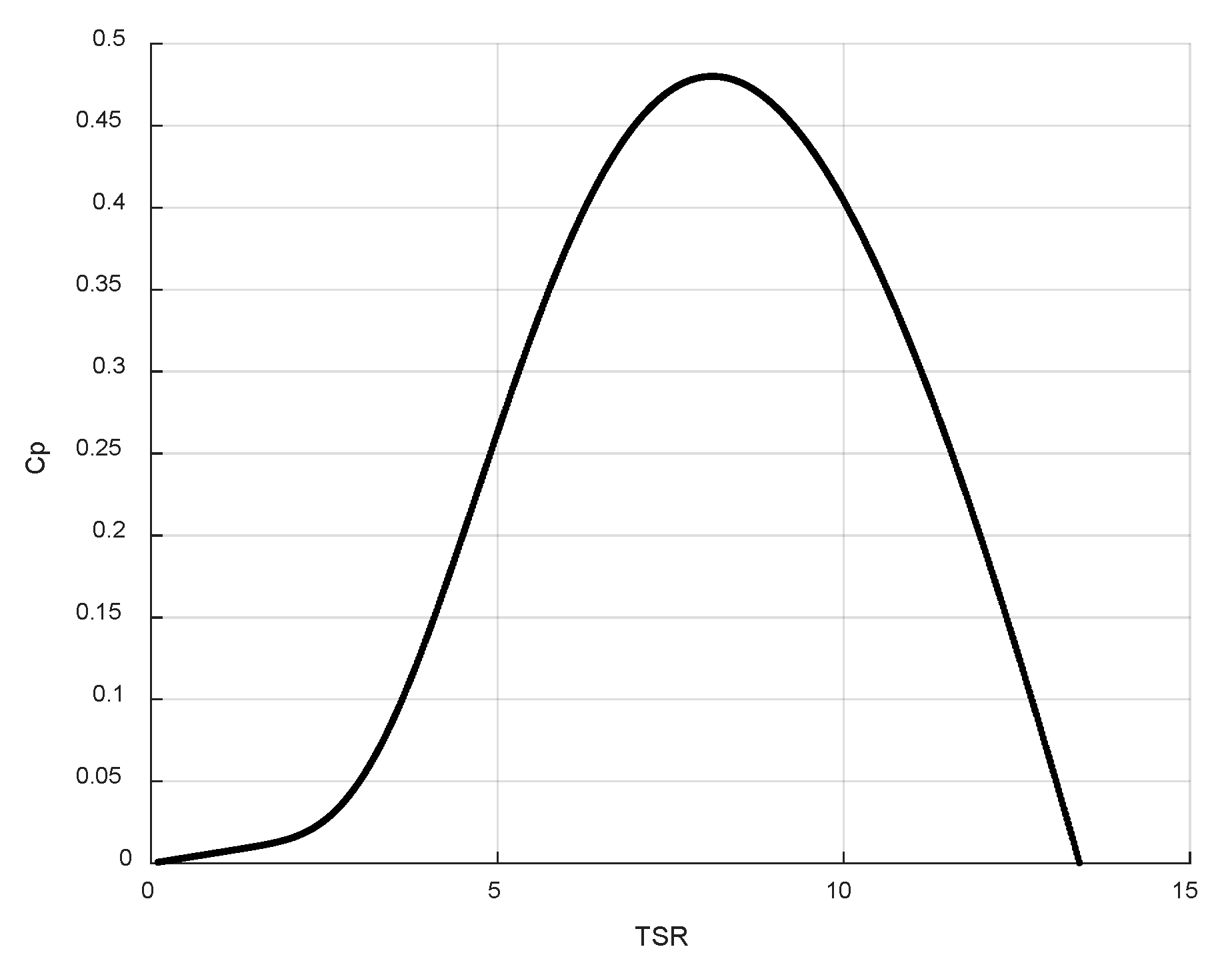


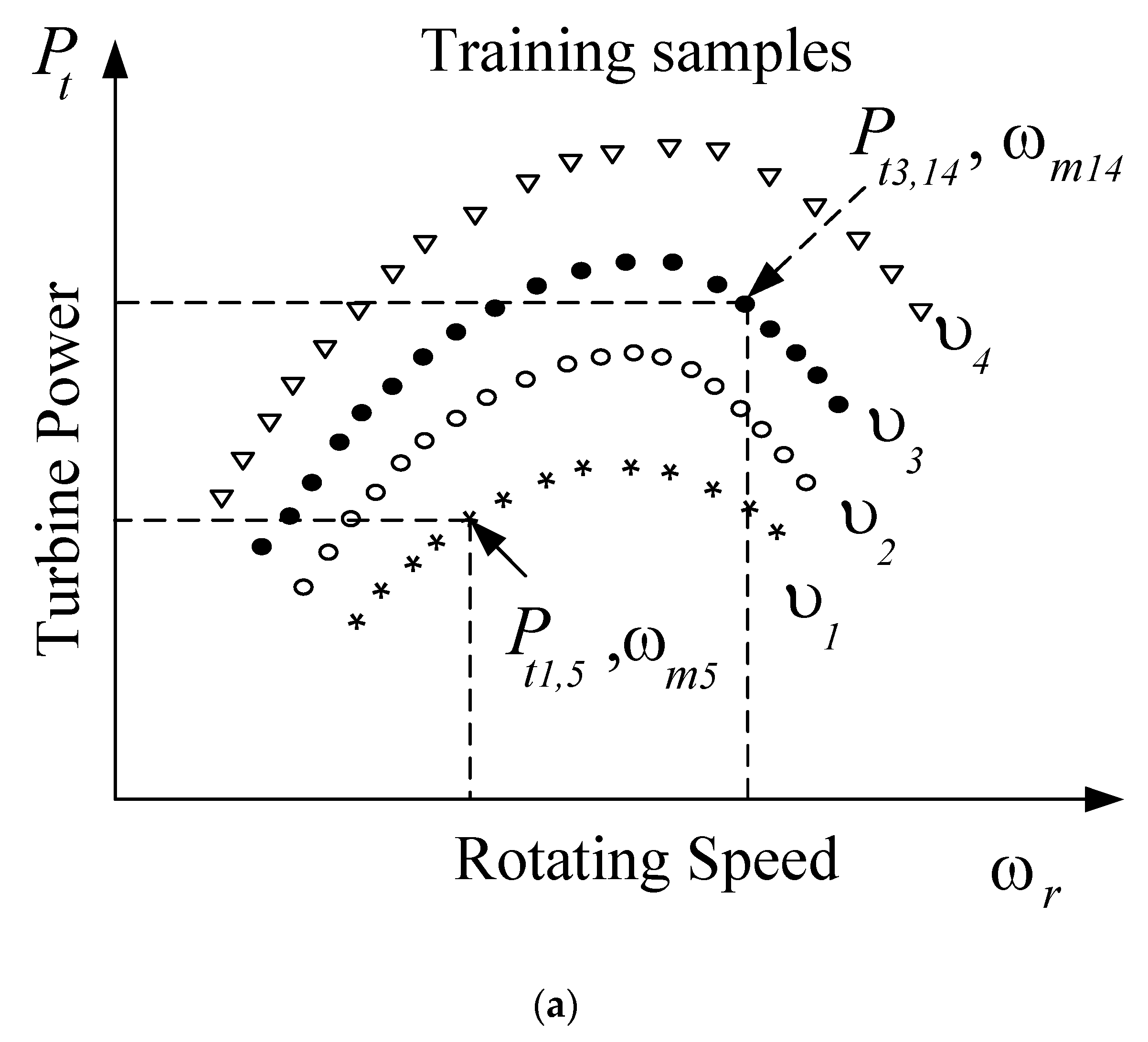

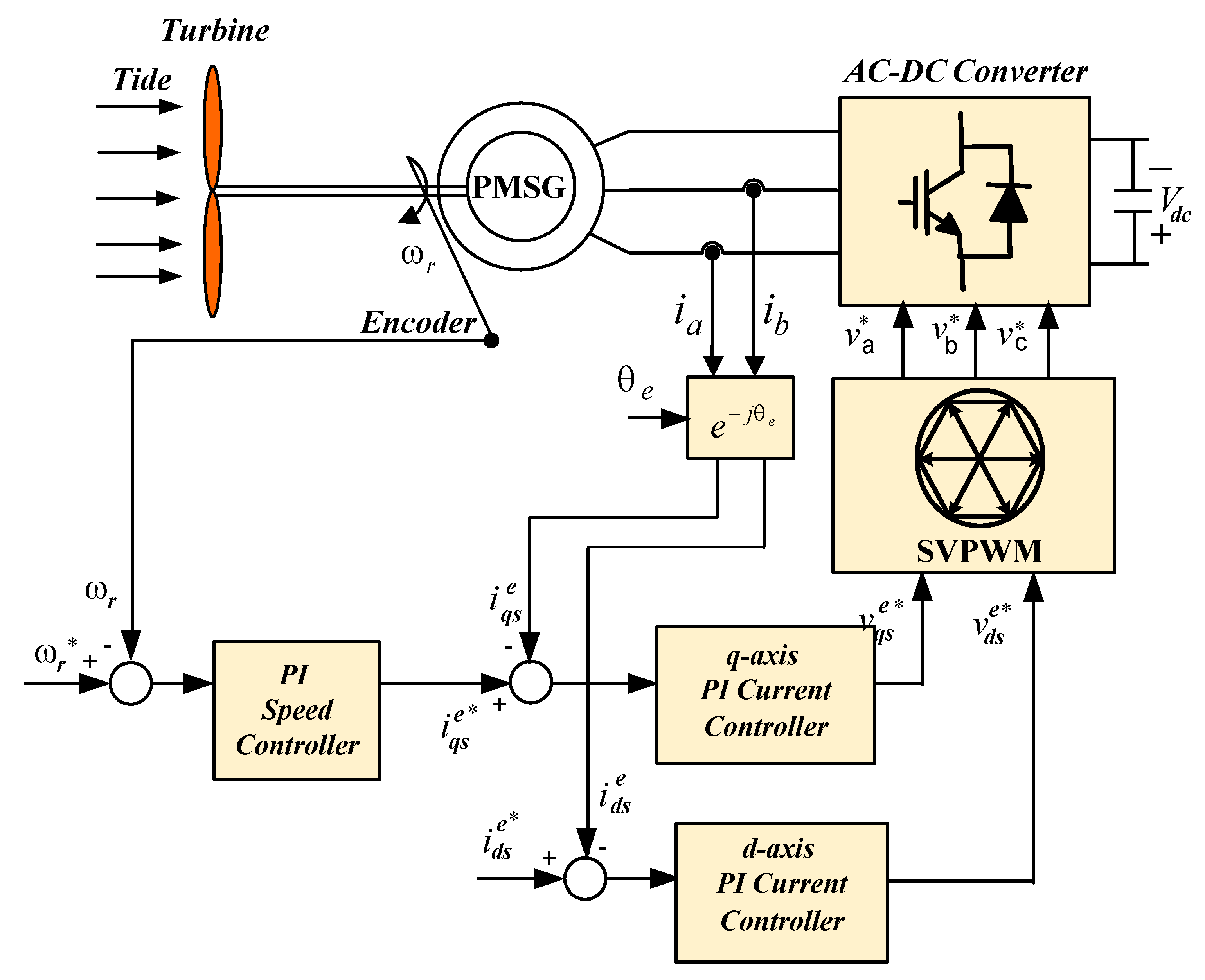
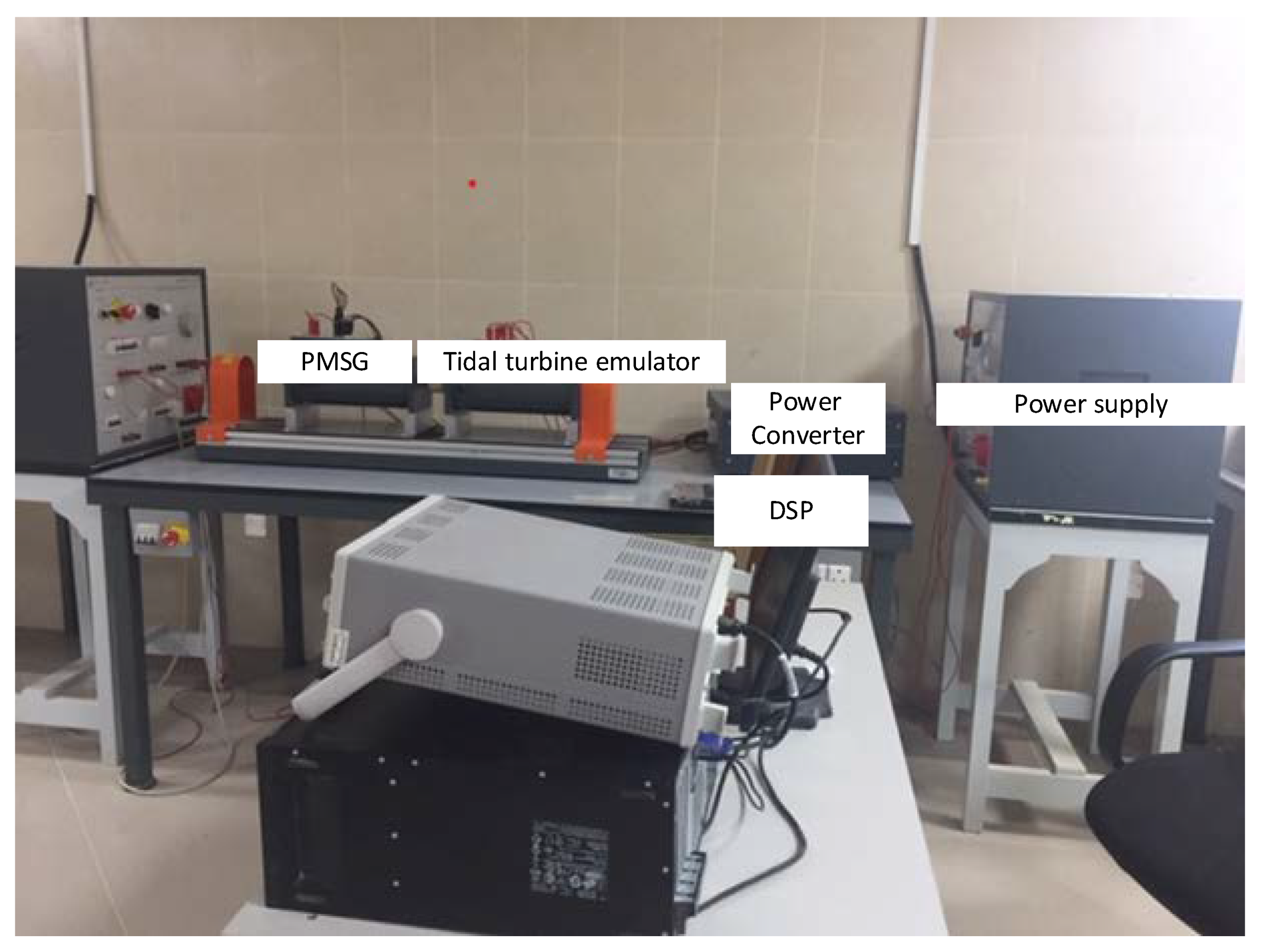


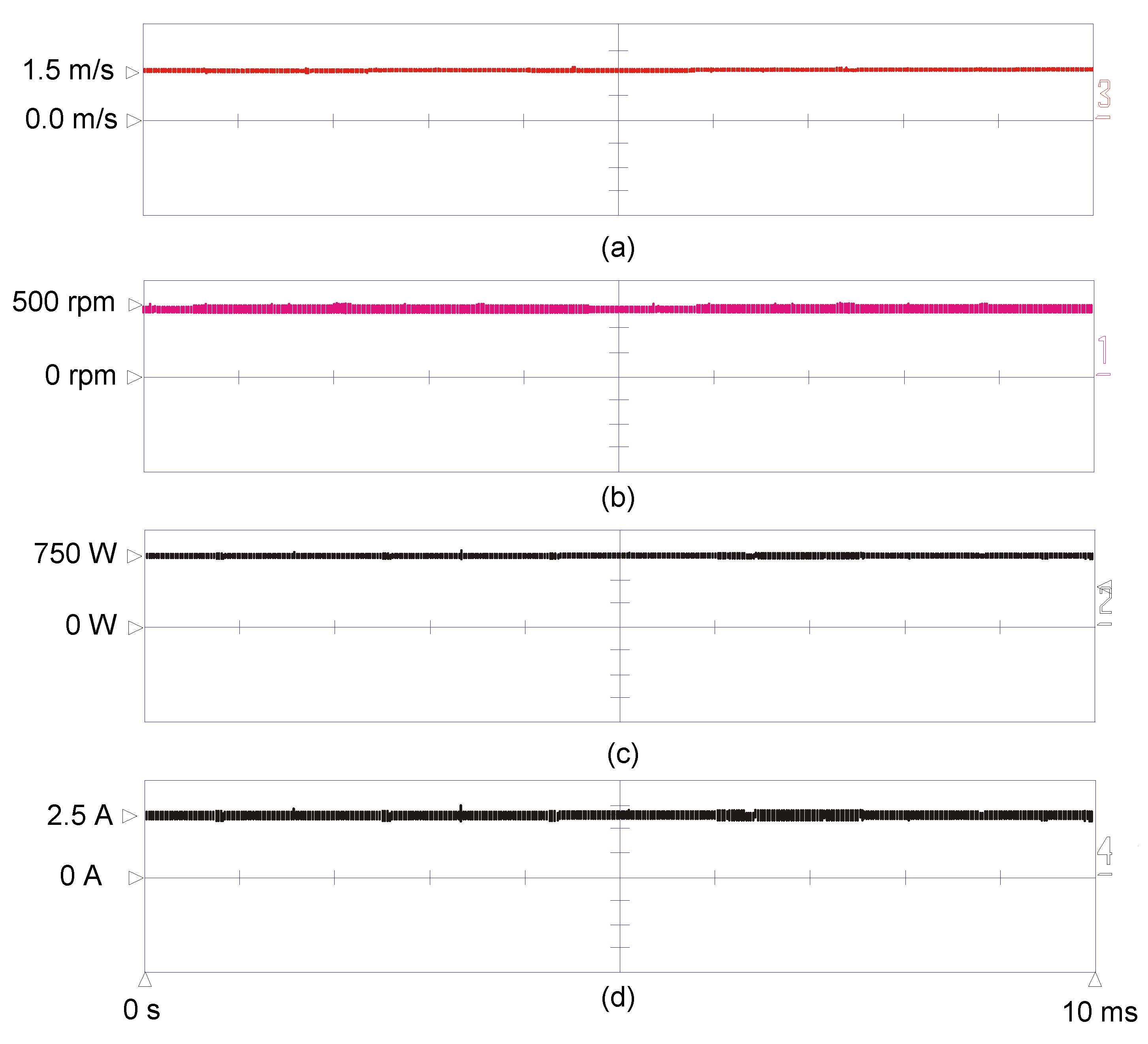
| Parameters | Value |
|---|---|
| Rated Power | 2.7 [kW] |
| Rated speed | 1200 [rpm] |
| Number of poles | 6 |
| Rated current | 9.5 [A] |
| Stator resistance | 0.5 [Ω] |
| d-axis inductance | 3 [mH] |
| q-axis inductance | 7 [mH] |
| Flux Linkage | 0.175 [Wb] |
| Moment of inertia | 1.8 × 10−3 [kg.m2] |
Publisher’s Note: MDPI stays neutral with regard to jurisdictional claims in published maps and institutional affiliations. |
© 2021 by the authors. Licensee MDPI, Basel, Switzerland. This article is an open access article distributed under the terms and conditions of the Creative Commons Attribution (CC BY) license (http://creativecommons.org/licenses/by/4.0/).
Share and Cite
Abo-Khalil, A.G.; Alghamdi, A.S. MPPT of Permanent Magnet Synchronous Generator in Tidal Energy Systems Using Support Vector Regression. Sustainability 2021, 13, 2223. https://doi.org/10.3390/su13042223
Abo-Khalil AG, Alghamdi AS. MPPT of Permanent Magnet Synchronous Generator in Tidal Energy Systems Using Support Vector Regression. Sustainability. 2021; 13(4):2223. https://doi.org/10.3390/su13042223
Chicago/Turabian StyleAbo-Khalil, Ahmed G., and Ali S. Alghamdi. 2021. "MPPT of Permanent Magnet Synchronous Generator in Tidal Energy Systems Using Support Vector Regression" Sustainability 13, no. 4: 2223. https://doi.org/10.3390/su13042223
APA StyleAbo-Khalil, A. G., & Alghamdi, A. S. (2021). MPPT of Permanent Magnet Synchronous Generator in Tidal Energy Systems Using Support Vector Regression. Sustainability, 13(4), 2223. https://doi.org/10.3390/su13042223







